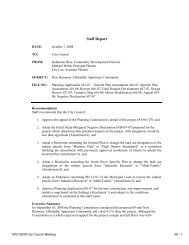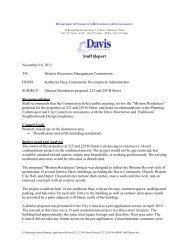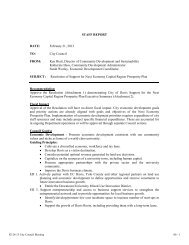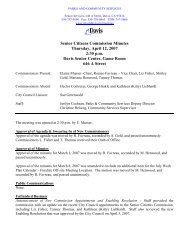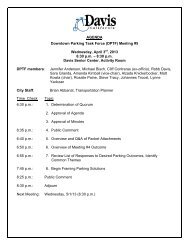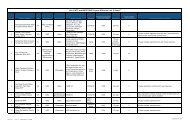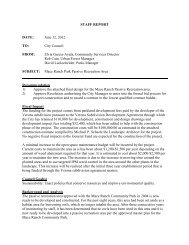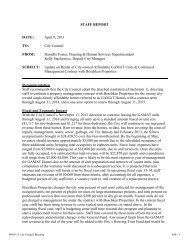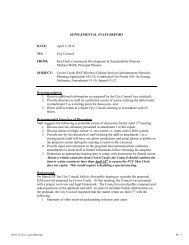10 Draft Integrated Waste Management Plan - City Council - City of ...
10 Draft Integrated Waste Management Plan - City Council - City of ...
10 Draft Integrated Waste Management Plan - City Council - City of ...
You also want an ePaper? Increase the reach of your titles
YUMPU automatically turns print PDFs into web optimized ePapers that Google loves.
2012 Davis <strong>Integrated</strong> <strong>Waste</strong> <strong>Management</strong> <strong>Plan</strong><br />
yard debris that the claw may leave behind. This weekly street sweeping makes loose-in-the-street collection<br />
costly for Davis. If Davis were to shift to collecting yard materials in carts, it may be possible to reduce street<br />
sweeping service to only once per month, resulting in an overall cost savings. In contrast, the <strong>City</strong> <strong>of</strong> San Jose<br />
<strong>of</strong>fers loose-in-the-street collection <strong>of</strong> yard materials and only performs street sweeping monthly; they have<br />
been able to see a cost savings with their loose-in-the-street collection.<br />
Another issue <strong>of</strong> concern is the effect that loose-in-the-street yard materials collection may have on storm water<br />
quality. Initially, the Regional Water Quality Control Board (RWQCB) staff, in review <strong>of</strong> the <strong>City</strong>’s Storm<br />
Water <strong>Management</strong> <strong>Plan</strong> (SWMP) submitted in March 2003, had found the current yard material management<br />
program to be inadequate. RWQCB staff contended that loose yard material in the street degraded storm water<br />
quality and emphasized that yard material containerization or its equivalent was needed. See section 5 for more<br />
details on the RWQCB, yard materials and street sweeping.<br />
In December 2006, the <strong>City</strong> was issued a storm water permit that did not require containerization. The permit<br />
did require enhanced education on the proper placement <strong>of</strong> yard material piles. At present, there is no science<br />
to indicate what the collection method effect on the amount <strong>of</strong> organics in storm water is, however, it is very<br />
possible that future permits could continue to advocate or require containerization. It should be noted however,<br />
Perhaps one <strong>of</strong> the most contentious points in the containerization debate is the concern for bicycle safety. The<br />
current collection method <strong>of</strong> yard materials loose in the street poses safety concerns for bicycle riders. The<br />
conflict between piles <strong>of</strong> yard materials and bicyclists in the same bike lane has been recognized over the years<br />
and appears in the <strong>City</strong> <strong>of</strong> Davis Bicycle <strong>Plan</strong> as an issue needing improvement. This is a public safety issue.<br />
Yard material carts may also pose a hazard to bicyclists, if they are place in the bike lane. To limit this potential<br />
hazard, the <strong>City</strong> <strong>of</strong> Sacramento placed a notice on their yard material carts to draw attention to bicycle safety,<br />
see the figure below.<br />
FIGURE 4-3 BIKE LANE WARNING ON YARD MATERIAL CART<br />
DRAFT<br />
Aesthetics have been another argument in favor <strong>of</strong> containerization. Over the last several years, especially after<br />
converting to automated trash and recycling pick up, some residents have voiced their preference for<br />
containerized pick up for yard materials. The concern is the aesthetics <strong>of</strong> having yard materials loose in the<br />
street and blowing material on windy days. During pick-up, loose materials are spread and dispersed in the<br />
wake <strong>of</strong> “the claw”.<br />
Several options for containerization are possible:<br />
Containerized yard materials only<br />
Containerized yard materials, then later food scraps<br />
Page | 4-11



